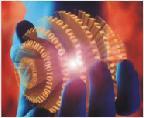Somebody have used chat in class...what happened?

Antecedents
Schutte (1996) reports on an experimental study made with 33 students of Social Statistic in the University of the State of California. The group divided itself in two and it was assigned, at random, the one to a traditional class and other to a virtual class. To first a traditional education occurred him, whereas to the seconds it was taught to them virtually using resources like chat, the electronic mail, hypernews and the WWW. The results showed that the virtual class demonstrated greater group work, more flexibility, better understanding of the material and a more positive feeling towards the mathematics, in comparison with the traditional class.
Neal (1997) in a comparative study between several means (chat, electronic mail, videoconferencia, audio conference and, Netmeeting), at a distance indicated to the benefits and difficulties found during the use of chat in its classes. On the matter, the author observed that the IRC endorsed the group interaction, at the same time who allowed the conversation deprived between the participants. Also she found that this average one was ideal to carry out evaluations of the course; in this case the educational one prepared a series of questions and it raised them during the accomplishment of the encounter. All the participants responded and, at the same time, they could make observations on the commentaries expressed by the other companions.
In another study, Kroonenberg (1995) indicates some benefits that chat like average discussing obtained with its French students of baccalaureate, using and debating its ideas. Between the advantages it mentions as the synchronous communication by means of chat allowed the students to practice the fast interaction. Another advantage that offered east means him was the opportunity to reflect in half of an interaction leaning in the written text that appeared in screen. Finally it mentions that many students were more expressive in this means of which they were it in the written compositions normal. These studies suggest important results with respect to the possibilities of didactic use of chat, for example, to promote the colaborativo learning between the students, besides to help to surpass expresivas inhibitions. The term of the Computer Mediated Communication, (CMC). Santoro (mentioned in Simonson, M., Sh. Smaldino, M. Albright & S. Svacek, 2000) describes it like the set of applications of the computer that are used with the purpose of ensure communications. According to this author there are three categories of functions in which the communication is mediated trough the computer.
First, the conference, within which we have the electronic mail, the discussion lists and the electronic conference - here the forum and chat are located. The second category, computer science, talks about the on line resources that support the learning like catalogues of the libraries, index and data base. The last category, the computer assited instruction, remind us to the interactive learning using the computer as tool in order to facilitate the profit of the objectives on the part of the student.
For Berge & Collins (1995) the computer mediated communication, describes the form in which the humans use the computerized systems and the networks to transfer, to store and to recover information, although add that the emphasis is always in the term communication. Between the multiple uses of the communication by the computer, these authors mention the instruction based on projects, the consultations, the public conference, the individual and group recovery of the information, presentations, the learning in equipment, and chat interactive. The advantages that the computer mediated communication offers relate to the liberation of the limits of time and space in relation to the instruction, the promotion of the self-discipline, the incentive towards the colaborativo work, the equality between the users and the promotion of the multicultural conscience (Berge & Collins, 1995).

0 Comments:
Post a Comment
<< Home